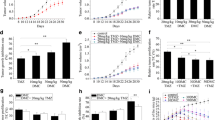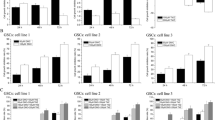Abstract
Purpose
Glioblastoma multiforme (GBM) is a poorly curable disease due to its profound chemoresistance. Despite recent advances in surgery, radiotherapy and chemotherapy, the efficient treatment of GBMs is still a clinical challenge. Beside others, AT101, the R-(−) enantiomer of gossypol, and demethoxycurcumin (DMC), a curcumin-related demethoxy compound derived from Curcuma longa, were considered as possible alternative drugs for GBM therapy.
Methods
Using different human primary GBM cell cultures in a long-term stimulation in vitro model, the cytotoxic and anti-proliferative effects of single and combined treatment with 5 µM AT101 and 5 µM or 10 µM DMC were investigated. Furthermore, western blots on pAkt and pp44/42 as well as JC-1 staining and real-time RT-PCR were performed to understand the influence of the treatment at the molecular and gene level.
Results
Due to enhanced anti-proliferative effects, we showed that combined therapy with both drugs was superior to a single treatment with AT101 or DMC. Here, by determination of the combination index, a synergism of the combined drugs was detectable. Phosphorylation and thereby activation of the kinases p44/42 and Akt, which are involved in proliferation and survival processes, were inhibited, the mitochondrial membrane potential of the GBM cells was altered, and genes involved in dormancy-associated processes were regulated by the combined treatment strategy.
Conclusion
Combined treatment with different drugs might be an option to efficiently overcome chemoresistance of GBM cells in a long-term treatment strategy.




Similar content being viewed by others
Abbreviations
- BSA:
-
Bovine serum albumin
- CI:
-
Combination index
- DMC:
-
Demethoxycurcumin
- DMEM:
-
Dulbecco’s modified Eagle’s medium
- DMSO:
-
Dimethylsulfoxide
- EphA5:
-
Ephrin type-A receptor 5
- FBS:
-
Fetal bovine serum
- GAPDH:
-
Glycerinaldehyde 3-phosphate dehydrogenase
- GBM:
-
Glioblastoma multiforme
- H2BK:
-
Histone cluster 1 H2B family member K
- IGFBP5:
-
Insulin-like growth factor-binding protein 5
- OD:
-
Optical density
- PBS:
-
Phosphate-buffered saline
- PC:
-
Primary culture
- qRT-PCR:
-
Quantitative real-time polymerase chain reaction
- TBS-T:
-
Tris-buffered saline with 0.1% Tween
- TMZ:
-
Temozolomide
References
Adamski V, Hempelmann A, Flüh C, Lucius R, Synowitz M, Hattermann K, Held-Feindt J (2017) Dormant glioblastoma cells acquire stem cell characteristics and are differentially affected by Temozolomide and AT101 treatment. Oncotarget 8:108064–108078
Adamski V, Schmitt C, Ceynowa F, Adelung R, Lucius R, Synowitz M, Hattermann K, Held-Feindt J (2018) Effects of sequentially applied single and combined temozolomide, hydroxychloroquine and AT101 treatment in a long-term stimulation glioblastoma in vitro model. J Cancer Res Clin Oncol 144:1475–1485
Almog N (2010) Molecular mechanism underlying tumor dormancy. Cancer Lett 294:139–146
Almog N, Ma L, Raychowdhury R, Schwager C, Erber R, Short S, Hlatky L, Vajkoczy P, Huber PE, Folkman J, Abdollahi A (2009) Transcriptional switch of dormant tumors to fast-growing angiogenic phenotype. Cancer Res 69:836–844
Antonietti P, Linder B, Hehlgans S, Mildenberger IC, Burger MC, Fulda S, Steinbach JP, Gessler F, Rödel F, Mittelbronn M, Kögel D (2017) Interference with the HSF1/HSP70/BAG3 pathway primes glioma cells to matrix detachment and BH3 mimetic-induced apoptosis. Mol Cancer Ther 16:156–168
Burotto M, Chiou VL, Lee J-M, Kohn EC (2014) The MAPK pathway across different malignancies: a new perspective. Cancer 120:3446–3456
Bushunow P, Reidenberg MM, Wasenko J, Winfiled J, Lorenzo B, Lemke S, Himpler B, Corona R, Coyle T (1999) Gossypol treatment of recurrent adult malignant gliomas. J Neurooncol 43:79–86
Chen L, Shi L, Wang W, Zhou Y (2017) ABCG2 downregulation in glioma stem cells enhances the therapeutic efficacy of demethoxycurcumin. Oncotarget 8:43237–43247
Chou TC (2006) Theoretical basis, experimental design, and computerized simulation of synergism and antagonism in drug combination studies. Pharmacol Rev 58:621–681
Guo Z, Zhao J, Song L, Ma JX, Wang CJ, Pei SY, Jiang C, Li SB (2014) Induction of H2AX phosphorylation in tumor cells by gossypol acetic acid is mediated by phosphatidylinositol 3-kinase (PI3K) family. Cancer Cell Int 14:e141
Hattermann K, Held-Feindt J, Lucius R, Sebens Müerköster S, Penfold MET, Schall TJ, Mentlein R (2010) The chemokine receptor CXCR7 is highly expressed in human glioma cells and mediates anti-apoptotic effects. Cancer Res 70:3299–3308
Huang TY, Hsu CW, Chang WC, Wang MY, Wu JF, Hsu YC (2012) Demethoxycurcumin retards cell growth and induces apoptosis in human brain malignant glioma GBM 8401 cells. Evid Based Complement Altern Med 2012:396573
Jarzabek A, Amberger-Murphy V, Callanan JJ, Gao C, Zagozdzon AM, Shiels L, Wang J, Ligon KL, Rich BE, Dicker P, Gallagher WM, Prehn JHM, Byrne AT (2014) Interrogation of gossypol therapy in glioblastoma implementing cell line and patient-derived tumour models. Br J Cancer 111:2275–2286
Keshmiri-Neghab H, Goliaei B, Nikoofar A (2014) Gossypol enhances radiation-induced autophagy in glioblastoma multiforme. Gen Physiol Biophys 33:433–442
Kumar R, Lal N, Nemaysh V, Luthra PM (2018) Demethoxycurcumin mediated targeting of MnSOD leading to activation of apoptotic pathway and inhibition of Akt/NF-κB survival signalling in human glioma U87 MG cells. Toxicol Appl Pharmacol 345:75–93
Lal N, Nemaysh V, Luthra PM (2018) Proteasome mediated degradation of CDC25C and Cyclin B1 in demethoxycurcumin treated human glioma U87 MG cells to trigger G2/M cell cycle arrest. Toxicol Appl Pharmacol 356:76–89
Li F, Xia Y, Meiler J, Ferguson-Miller S (2013) Characterization and modeling of the oligomeric state and ligand binding behavior of purified translocator protein 18 kDa from Rhodobacter sphaeroides. Biochemistry 52:5884–5899
Louis DN, Perry A, Reifenberger G, von Deimling A, Figarella-Branger D, Cavenee WK, Ohgaki H, Wiestler OD, Kleihues P, Ellison DW (2016) The 2016 World Health Organization classification of tumors of the central nervous system: a summary. Acta Neuropathol 131:803–820
Lu Y, Li J, Dong C-E, Huang J, Zhou H-B, Wang W (2017) Recent advances in gossypol derivatives and analogs: a chemistry and biology view. Future Med Chem 9:1243–1275
Luthra PM, Kumar R, Prakash A (2009) Demethoxycurcumin induces Bcl-2 mediated G2/M arrest and apoptosis in human glioma U87 cells. Biochem Biophys Res Commun 384:420–425
Meyer N, Zielke S, Michaelis JB, Linder B, Warnsmann V, Rakel S, Osiewacz HD, Fulda S, Mittelbronn M, Münch C, Behrends C, Kögel D (2018) AT101 induces early mitochondrial dysfunction and HMOX1 (heme oxygenase 1) to trigger mitophagic cell death in glioma cells. Autophagy 14:1693–1709
Opydo-Chanek M, Gonzola O, Marzo I (2017) Multifaceted anticancer activity of BH3 mimetics: current evidence and future prospects. Biochem Pharmacol 136:12–23
Ostrom QT, Gittleman H, Truitt G, Boscia A, Kruchko C, Barnholtz-Sloan JS (2018) CBTRUS statistical report: primary brain and other central nervous system tumors diagnosed in the United States in 2011–2015. Neuro Oncol 20:iv1–iv86
Perry SW, Norman JP, Barbieri J, Brown EB, Gelbard HA (2011) Mitochondrial membrane potential probes and the proton gradient: a practical usage guide. Biotechniques 50:98–115
Rai SN, Dilnashin H, Birla H, Singh SS, Zahra W, Rathore AS, Singh BK, Singh SP (2019) The role of PI3K/Akt and ERK in neurodegenerative disorders. Neurotox Res 35:775–795
Sandur SK, Pandey MK, Sung B, Ahn KS, Murakami A, Sethi G, Limtrakul P, Badmaev V, Aggarwal BB (2007) Curcumin, demethoxycurcumin, bisdemethoxycurcumin, tetrahydrocurcumin and turmerones differentially regulate anti-inflammatory and anti-proliferative responses through a ROS-independent mechanism. Carcinogenesis 8:1765–1773
Satchi-Fainaro R, Ferber S, Segal E, Ma L, Dixit N, Ijaz A, Hlatky L, Abdollahi A, Almog N (2012) Prospective identification of glioblastoma cells generating dormant tumors. PLoS ONE 7:e44395
Shi L, Sun G (2015) Low-dose DMC significantly enhances the effect of TMZ on glioma cells by targeting multiple signaling pathways both in vivo and in vitro. Neuromolecular Med 17:431–442
Shi L, Sun G (2018) DMC is not better than TMZ on intracranial anti-glioma effects. J Cell Biochem 119:6057–6064
Somparn P, Phisalaphong C, Nakornchai S, Unchern S, Morales NP (2007) Comparative antioxidant activities of curcumin and its demethoxy and hydrogenated derivatives. Biol Pharm Bull 30:74–78
Stupp R, Mason WP, van den Bent MJ, Weller M, Fisher B, Taphoorn MJ, Belanger K, Brandes AA, Marosi C, Bogdahn U, Curschmann J, Janzer RC, Ludwin SK, Gorlia T, Allgeier A, Lacombe D, Cairncross JG, Eisenhauer E, Mirimanoff RO, European Organisation for Research, and Treatment of Cancer Brain Tumor, and Radiotherapy Groups, National Cancer Institute of Canada Clinical Trials Group (2005) Radiotherapy plus concomitant and adjuvant temozolomide for glioblastoma. N Engl J Med 352:987–996
Voss V, Senft C, Lang V, Ronellenfitsch MW, Steinbach JP, Seifert V, Kögel D (2010) The pan-Bcl-2 inhibitor (−)gossypol triggers autophagic cell death in malignant gliomas. Mol Cancer Res 8:1002–1016
Wang J, Peng Y, Liu Y, Yang J, Huang M, Tan W (2015) AT101 inhibits hedgehog pathway activity and cancer growth. Cancer Chemother Pharmacol 76:461–469
Warnsmann V, Meyer N, Hamann A, Kögel D, Osiewacz HD (2018) A novel role of the mitochondrial permeability transition pore in (−)gossypol-induced mitochondrial dysfunction. Mech Ageing Dev 170:45–58
Acknowledgements
We thank Fereshteh Ebrahim and Brigitte Rehmke for expert technical assistance.
Funding
This work was funded by the German Research Foundation (DFG) as part of the Research Training Group “Materials4Brain” (RTG2154; P8).
Author information
Authors and Affiliations
Contributions
JHF, CK, and CS conceived and designed the study; MM, VA, CS, and JHF performed the experiments and analyzed the data; CK and MS contributed materials and data and assisted in data analysis; JHF and MM wrote the paper; and all authors revised the manuscript.
Corresponding author
Ethics declarations
Conflict of interest
Author Moiken Mehner declares that she has no conflict of interest. Author Carolin Kubelt declares that she has no conflict of interest. Author Vivian Adamski declares that she has no conflict of interest. Author Christina Schmitt declares that she has no conflict of interest. Author Michael Synowitz declares that he has no conflict of interest. Author Janka Held-Feindt declares that she has no conflict of interest.
Ethical approval
All procedures performed in studies involving human tumor samples were in accordance with the ethical standards of the institutional committee (ethics committee of the University of Kiel, Germany; file references: D471/15 and D524/17) and with the 1964 Helsinki Declaration and its later amendments. Written informed consent was obtained from all individual donors included in the study.
Additional information
Publisher's Note
Springer Nature remains neutral with regard to jurisdictional claims in published maps and institutional affiliations.
Rights and permissions
About this article
Cite this article
Mehner, M., Kubelt, C., Adamski, V. et al. Combined treatment of AT101 and demethoxycurcumin yields an enhanced anti-proliferative effect in human primary glioblastoma cells. J Cancer Res Clin Oncol 146, 117–126 (2020). https://doi.org/10.1007/s00432-019-03107-7
Received:
Accepted:
Published:
Issue Date:
DOI: https://doi.org/10.1007/s00432-019-03107-7




